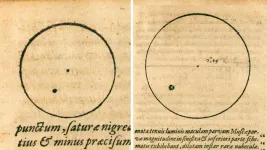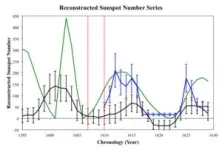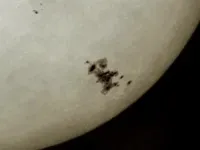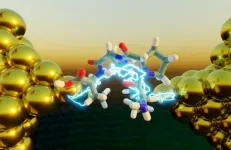(Press-News.org) Using modern techniques, researchers have re-examined Johannes Kepler's half-forgotten sunspot drawings and revealed previously hidden information about the solar cycles before the grand solar minimum. By recreating the conditions of the great astronomer’s observations and applying Spörer's law in the light of modern statistics, an international collaborative group led by Nagoya University in Japan has measured the position of Kepler’s sunspot group, placing it at the tail-end of the solar cycle before the cycle that Thomas Harriot, Galileo Galilei, and other early telescopic observers later witnessed.
The group’s findings, reported in Astrophysical Journal Letters, offer a key to resolving the controversy on the duration of solar cycles at the beginning of the 17th century, which are associated with the transition from regular solar cycles to the grand solar minimum, known as the Maunder Minimum (1645–1715). A grand solar minimum is an abnormally prolonged period of low sunspot activity, which is important for telling researchers about solar activity and its effect on the Earth.
KEPLER’S IMPORTANT OBSERVATIONS
Kepler, renowned for his historical achievements in astronomy and mathematics, made one of the earliest datable instrumental records of solar activity in the early 17th Century, before the earliest telescopic sunspot drawings. He used an apparatus known as a camera obscura, consisting of a small hole in a wall to project the Sun's image on to a sheet of paper, which allowed him to sketch visible features on the Sun.
In May 1607, he recorded what he mistakenly interpreted as a transit of Mercury across the Sun, later clarified to be a sunspot group sighting. Sunspots are areas on the Sun's surface that appear darker because of intense magnetic activity. Their occurrence, frequency, and latitudinal distributions appear in cycles that affect solar radiation and space weather.
Hisashi Hayakawa, the lead author of the study, believes that researchers have underappreciated the significance of this finding. “Since this record was not a telescopic observation, it has only been discussed in the context of the history of science and had not been used for quantitative analyses for the solar cycles in the 17th century,” he said. “But this is the oldest sunspot sketch ever made with an instrumental observation and a projection.”
He continued: “We realized that this sunspot drawing should be able to tell us the location of the sunspot and indicate the solar cycle phase in 1607 as long as we managed to narrow down the observation point and time and reconstruct the tilt of the heliographic coordinates – meaning the positions of features on the Sun's surface – at that point in time.”
THE 17TH CENTURY: A KEY TIME FOR ASTRONOMY
The observations were important because the 17th century was a pivotal period in the solar cycle, not only as the time when sunspot observations had just begun but also when solar activity transitioned from normal solar cycles to the Maunder Minimum, a unique grand solar minimum in observational history.
It is not fully understood how the pattern of solar activity shifted from regular cycles to the grand minimum, other than that the transition was gradual. One of the previous tree-ring-based reconstructions claimed a sequence consisting of an extremely short solar cycle (≈ 5 years) and an extremely long solar cycle (≈ 16 years), associating these anomalous solar-cycle durations with a precursor of the transition from regular solar cycles to the grand solar minimum.
“If true, this would indeed be interesting. However, another tree-ring-based reconstruction indicated a sequence of solar cycles with normal durations,” said Nagoya University’s Hisashi Hayakawa; “Then, which reconstruction should we trust? It is extremely important to check these reconstructions with independent – preferably observational – records.”
FOUR KEY FINDINGS
Kepler’s sunspot record is a key observational reference. By analysing Kepler’s records and comparing them with contemporaneous data and modern statistics, the researchers made several important discoveries:
First, after ‘deprojecting’ Kepler’s sunspot drawings and compensating for the solar position angle, they placed Kepler’s sunspot group at a low heliographic latitude. This suggests that the famous schematic drawing of the solar image that Kepler diagrammed in his book is not consistent with Kepler’s original text and the two camera obscura images, which show the sunspot in the upper left portion of the solar disk.
Second, by applying Spörer's law and the knowledge gained from modern sunspot statistics, they identified the sunspot group as being probably located in the tail-end of solar cycle -13 rather than the beginning of solar cycle -14.
Third, their findings contrast with later telescopic observations, which show sunspots at higher latitudes. “This shows a typical transition from the preceding solar cycle to the following cycle, in accordance with Spörer’s law,” Thomas Teague, an observer for the WDC SILSO and a member of the team, said, referring to the German astronomer Gustav Spörer who described a migration of sunspots from higher to lower latitudes during a solar cycle.
Fourth, this finding allows the authors to approximate the transition between the previous solar cycle (-14) and the next solar cycle (-13) between 1607 and 1610, narrowing down the possible dates when it occurred. On this basis, Kepler’s records suggested a regular duration for solar cycle-13, challenging alternative reconstructions that propose an extremely long cycle during this period.
KEPLER’S LEGACY
“Kepler’s legacy extends beyond his observational prowess; it informs ongoing debates about the transition from regular solar cycles to the Maunder Minimum, a period of extremely reduced solar activity and anomalous hemispheric asymmetry between 1645 and 1715,” Hayakawa explained. “By situating Kepler’s findings within broader solar activity reconstructions, scientists gain crucial context for interpreting changes in solar behaviour in this pivotal period marking a transition from regular solar cycles to the grand solar minimum.”
“Kepler contributed many historical benchmarks in astronomy and physics in the 17th century, leaving his legacy even in the space age,” said Hayakawa. “Here, we add to that by showing that Kepler’s sunspot records predate the existing telescopic sunspot records from 1610 by several years. His sunspot sketches serve as a testament to his scientific acumen and perseverance in the face of technological constraints.”
Sabrina Bechet, a researcher at the Royal Observatory of Belgium, added, “As one of my colleagues told me, it is fascinating to see historical figures’ legacy records convey crucial scientific implications to modern scientists even centuries later. I doubt if they could have imagined their records would benefit the scientific community much later, well after their deaths. We still have a lot to learn from these historical figures, apart from the history of science itself. In the case of Kepler, we are standing on the shoulders of a scientific giant.”
END
Kepler’s 1607 pioneering sunspot sketches solve solar mysteries 400 years later
2024-07-26
ELSE PRESS RELEASES FROM THIS DATE:
A new therapeutic target offers a promising pathway for multiple sclerosis treatment
2024-07-26
Fukuoka, Japan – Researchers from Kyushu University have identified a potential therapeutic target for the treatment of advanced multiple sclerosis (MS), a potentially disabling condition associated with the central nervous system. In their latest study, conducted using an experimental mouse model of MS, they explored the role of connexin 43 (Cx43), a protein involved in cellular communication and cardiac function, and examined whether targeting this protein with specific blockers could improve ...
Recent insights and advances in treatment and management show promise in stemming the growing prevalence of diabetes
2024-07-26
A new paper surveying advances in diabetes pathogenesis and treatment explores the complex factors contributing to the onset and progression of the disease, suggesting that an understanding of these dynamics is key to developing targeted interventions to reduce the risk of developing diabetes and managing its complications.
In a paper published July 25 in a special 50th anniversary issue of the peer-reviewed journal Cell, the authors surveyed hundreds of studies that have emerged over the years looking at the causes underpinning types 1 (T1D) and 2 (T2D) diabetes and new treatments for the disease. They examine the role that genes, environmental factors, and ...
Folded peptides are more electrically conductive than unfolded peptides
2024-07-26
What puts the electronic pep in peptides? A folded structure, according to a new study in the Proceedings of the National Academy of Sciences.
Electron transport, the energy-generating process inside living cells that enables photosynthesis and respiration, is enhanced in peptides with a collapsed, folded structure. Interdisciplinary researchers at the Beckman Institute for Advanced Science and Technology combined single-molecule experiments, molecular dynamics simulations and quantum mechanics to validate their findings.
“This discovery provides a new understanding of how electrons flow through peptides ...
Biotechnology companies can sustain the pipeline of new drugs under the Inflation Reduction Act
2024-07-26
BENTLEY UNIVERSITY
New research from the Center for Integration of Science and Industry at Bentley University shows that differences between the financial structures of large pharmaceutical producers and smaller, emerging biotechnology companies creates synergies that contribute to the pipeline of new, innovative products in response to reductions in drug prices anticipated under the Inflation Reduction Act (IRA). While large pharmaceutical producers would likely reduce R&D spending in response to lower product revenues, R&D in smaller biotechnology companies is not likely to decrease and could sustain both corporate profits and new product ...
65 million Americans now own firearms for protection, suggests survey
2024-07-26
Some 65 million Americans now own firearms for protection—around 80% of the country’s estimated 81 million gun owners—suggest the results of a nationally representative survey carried out in 2023, and published online in the journal Injury Prevention.
This perceived need is changing the profile of gun owners, the findings indicate, with increasing numbers of women and those of minority ethnic backgrounds citing protection as the primary reason for owning a firearm.
In 2021, firearms caused the highest ...
More than 10-fold difference in rates of unintentional gun deaths across US states
2024-07-26
There’s more than a 10-fold difference in the rates of unintentional gun deaths across US states, with such incidents claiming more than 12,000 lives between 2001 and 2021, finds research published online in the journal Injury Prevention.
Poverty, rural residency, non-White ethnicity and firearms ownership are all associated with higher rates, the findings show.
Firearms kill over 130 Americans every day. Most of these deaths are intentional, but of the 48,830 firearm related deaths in 2021, 549 were unintentional, note the researchers. But it’s not clear if rates differ within and between states.
To explore this further, the researchers looked ...
Unplanned pregnancies among active service women likely curb US military readiness
2024-07-26
Unplanned pregnancies among active service women may be curbing overall US military readiness for action and compromising its Women Peace and Security objectives, suggests research published online in the journal BMJ Military Health.
That’s because they potentially result in the loss of an estimated 2.5 million to more than 4.5 million active duty days, depending on the denominator used, the findings indicate, with the highest rates among 18-24 year olds, those of White race, those deployed in junior ranks and those serving in the Army.
The researchers set out to assess the impact ...
High levels of ozone and grass pollen expected for Paris Olympics/Paralympics
2024-07-26
High levels of the respiratory irritant ozone and grass pollen are likely during the 2024 Olympic and Paralympic Games if hot, sunny weather prevails, suggests an analysis of historic air quality monitoring data for the city of Paris and surrounding area during previous summers, and published online in the British Journal of Sports Medicine.
Athletes can be affected by environmental factors, despite generally being in good physical condition, note the researchers. Breathing in air pollution during exercise may pose health risks, depending on exposure levels and underlying long term conditions, they add. Endurance athletes are particularly susceptible to allergic symptoms, they say.
To ...
CDA creates new industry partner program
2024-07-26
The University of Illinois Center for Digital Agriculture (CDA) has launched a new partnership program for industry members to strengthen their ties to academia, technology, multidisciplinary research and professional development in a joint effort to tackle the globe’s most pressing agricultural challenges.
Unveiled in June, the CDA Industry Partner Program (IPP) offers members the opportunity to collaborate with world-renowned researchers and field experts to solve complex problems facing the industry, whether they stem from a changing climate, personnel shortages or any other hurdles that spring up. IPP ...
Tulane study says new drug shows promise in clearing HIV from brain
2024-07-26
An experimental drug originally developed to treat cancer may help clear HIV from infected cells in the brain, according to a new Tulane University study.
For the first time, researchers at Tulane National Primate Research Center found that a cancer drug significantly reduced levels of SIV, the nonhuman primate equivalent of HIV, in the brain by targeting and depleting certain immune cells that harbor the virus.
Published in the journal Brain, this discovery marks a significant step toward eliminating HIV from hard-to-reach reservoirs where the virus evades otherwise effective treatment.
“This research is an important step ...




